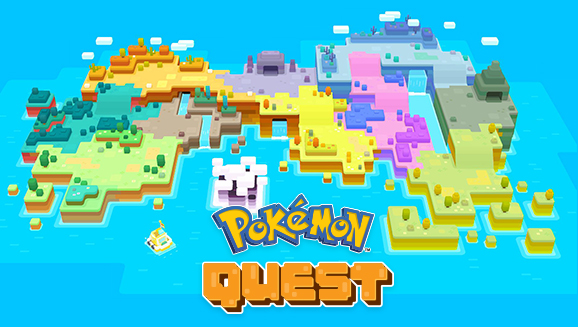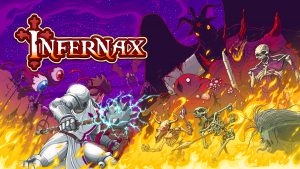
Pokémon Quest is a game that was inconspicuously released onto the Nintendo Switch on the same day as the Let’s Go Pikachu/Eevee announcement but, as a real-time strategy using Pokémon as the proverbial “troops”, it is very different to other titles that are attached to the franchise. The game is free with optional micro-transactions to accelerate gameplay. There are lots of free demos and try-the-game events on Nintendo Switch, but there are not many full free games available. As such, Pokémon Quest will set the bar for the quality and viability of free games on the platform.
You play as a researcher who has discovered a new island called Tumblecube Island. You send out your drone to explore it, but it keeps breaking down. As a substitute, you need to find some 1st Generation Pokémon ‘buddies’ to help you progress through the island and see all of its different locations. It’s a simple story that sits mostly in the background, but it reappears whenever you finish a set of levels. There are 3-5 levels in every area, excluding the bosses, who each possess a specific type weakness depending on type.
What makes it different?
Quest takes some new liberties with the franchise as Pokémon Go did. Many aspects of traditional Pokémon gameplay have been revamped and simplified. Quest has Pokémon battles that involve a team of 3 of your Pokémon against waves of enemies, with each Pokémon having up to 2 moves and a simple button input to use them. Each action has its own cooldown time and Pokémon will do basic attacks in between moves. There is a lot of variety in this respect with melee attacks, ranged attacks, buffs, debuffs and movement abilities. In a battle, you cannot choose where your Pokémon move but you can choose when to use your abilities, as well as when to scatter your team. This can be very important to avoid strong attacks by boss enemies and this function allows an additional level of strategy to a very simple game.

In every Pokémon game, the secondary goal is to “Catch ‘em all”, but in Pokémon Quest, you don’t use the traditional Poké Ball. Instead, you make tasty stew that attracts different Pokémon depending on what ingredients you use. Some recipes are obvious, Rock Pokémon like hard ingredients, but some are more difficult to figure out. All Pokémon evolve by leveling up and you can train them or change their moves by sacrificing other Pokémon.
One of the main mechanics in this game is preparing your squad by attaching Power Stones to your Pokémon to improve their stats. Attack stones improve their attack and Defence stones increase their hit points, as you might expect, and Move stones improve your moves in different ways, like reducing their cooldown or turning a solo buff into a team buff. The higher your Pokémon’s level, the more stones you can attach, but this can sometimes vary. Choosing your squad and their Power Stones is an integral part of the strategy behind Pokémon Quest.
Just another spinoff?
Pokémon Quest is built around grinding and, even though the micro-transactions are able to make the grind less time-consuming, the do not allow you to skip it all together. The game does, however, have many redeeming qualities that keep you engaged enough to stick with it. The art style of the game is visually appealing and very different to the usual design of a Pokémon game. It maintains the “optimisation” gameplay that is present in other games in the franchise but makes it much more accessible. This is similarly true for the Auto feature; you can bypass the real-time strategy gameplay if you have prepared enough to allow for the AI’s mistakes. There are also small variations in each level to add variety if/when you can’t beat the next one.
Unfortunately, Pokémon Quest does suffer from some of the common drawbacks of free-to-play games, like limited play sessions and a reliance on luck. A lot of outcomes happen randomly, including the loot you find (items and power stones), as well as the Pokémon you befriend. This is a necessary evil to elongate playtime (and sell premium currency), but it can be very irritating in certain cases. When you are changing a Pokémon’s move, a new move is randomly selected and it can lead to many failed attempts to get the set you want.
Unlike most other games on the platform, Pokémon Quest does not play very well in non-touch formats. The game is designed to be played using the touch screen and every other method is definitely inferior, but this does spark a conversation about the Switch as a portable console. Will Nintendo attempt to gain a larger share of the portable market by having more free games, following the examples of Android and IOS gaming?
Conclusion
As a game, Pokémon Quest achieves what it has set out to do. It has successfully introduced a more casual, mobile-like game to the Switch by creating “baby’s-first” RTS. It harbours a small but passionate community and is still incredibly accessible, similar to it’s big brother in the free-to-play model, Pokémon Go. Nintendo will likely continue to update the game, adding the new generations of Pokémon along with it. It’s a fun and engaging title that offers enough strategy to feel rewarding but is simple enough to be enjoyed by anyone.
Rating: 8/10
Pokémon Quest is available now for the Nintendo Switch








whoah this blog is great i love reading your articles. Keep up the great work! You know, a lot of people are searching around for this information, you could help them greatly.